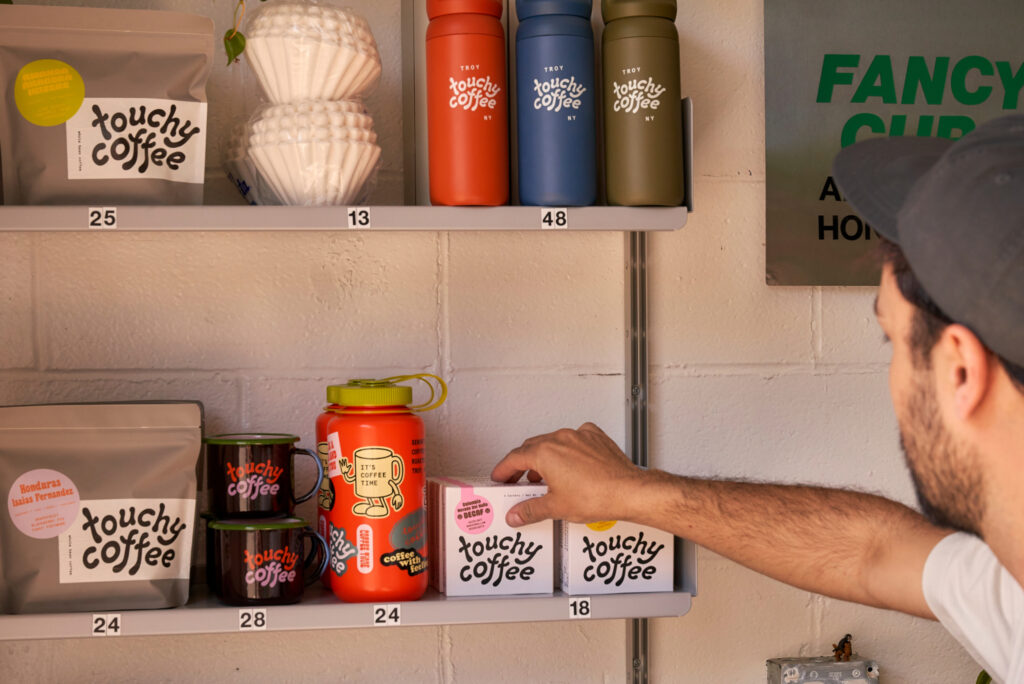

As a retailer, setting a reasonable price is a crucial part of running a profitable business. Price a product too high, you may not move products quickly enough. Price it too low, and now you’re eating into your bottom line.
Setting prices is a tough but critical part of running a profitable business. And it’s especially important for independent retailers since small changes to your profit margin can make an outsize impact. Let’s break down the hows and whys retailers choose prices for their products, so you can plan with confidence.
What are retail prices?
A product’s journey from manufacturing to purchasing follows a clear path. It starts with wholesalers, who sell goods in bulk to retailers. As products move through the supply chain, their price increases at each step until they reach the store shelf. This is where you see the final retail price—the amount a customer pays at checkout.
This price isn’t chosen randomly; retailers carefully consider multiple factors—like their initial costs, supply and demand, market trends, and local competition—to set a price that works for both their business and their customers.
What’s the difference between retail price and MSRP?
You’ve likely heard of MSRP, the manufacturer’s suggested retail price. People sometimes use this term interchangeably with retail price, but there’s a key difference. As you might guess from its name, the MSRP is just the recommended retail price. It’s a helpful number to have in the back of your head, but retailers don’t have to mark an item at this price; they can set their own prices to sell in stores.
Retailers might decide to sell above, below, or equal to the MSRP depending on their business strategy. The main advantage of using the MSRP as your retail price is it can give you a clear and consistent benchmark for pricing that’s aligned with the industry standard.
What might influence the prices you set?
Different types of stores have different pricing needs … and since independent shops often don’t have the financial cushion that big-box stores do, savvy pricing is vital. While you can use the MSRP as a starting point, there are plenty of reasons you might choose a different price—and some are more psychological than you might think! Here are some considerations to keep in mind:
-
Profitability: As we mentioned above, your retail price needs to generate enough of a profit margin for your business to be sustainable. Calculate how much you need to mark up the wholesale price to be in the black.
- Shopper perception: Your prices should make sense for your target audience and be in line with their expectations. Consider whether you’re targeting luxury shoppers, bargain hunters, or someone in between. For example, in a fancy boutique, if an item is priced too low, a shopper might wonder whether it’s poor quality. They might not feel like they’re buying something special and luxurious after all.
Competition: Sometimes the price you set can be influenced by other stores’ choices. Is the shop next door selling the same item for a lower price? If so, you’ll likely lose out on those sales. Think about the volume of sales necessary to make a discount worthwhile.
How to price items for retail: A step-by-step guide
This comprehensive guide breaks down the retail pricing process into manageable steps, so you can develop a pricing strategy that works for your business and resonates with your customers.
Step 1: Choose a pricing strategy
It’s crucial to understand the various pricing strategies available to retailers. Later on in this article, we will outline different approaches to pricing and how they might work for your business. Consider how each strategy aligns with your brand values and market position.
When making your decision, you should focus on:
- Understanding core pricing strategies (cost-plus, competitive, value-based)
- Analyzing which strategies are commonly used in your market
- Studying how successful competitors approach pricing
- Considering whether a hybrid approach might work best
Step 2: Identify business goals
Your pricing should directly support your broader business objectives, whether that’s rapid growth, maintaining premium positioning, or maximizing profitability.
Consider these key elements:
- Profit margin targets
- Market positioning goals
- Sales volume objectives
- Inventory turnover expectations
Think carefully about how your pricing will affect your brand perception. High-end boutiques might focus on premium pricing to reinforce their luxury positioning, while discount retailers might prioritize competitive pricing to drive volume.
Step 3: Research your target market
Understanding your customer base is essential for successful pricing. This step involves more than just gathering demographic data—it’s about truly understanding what drives your customers’ purchasing decisions.
Begin by conducting thorough market research:
- Survey existing and potential customers
- Analyze local demographic data
- Study purchasing patterns in your area
- Evaluate price sensitivity in your market
Remember that customer perception of value varies significantly across different market segments. What seems expensive to one customer might be perceived as a bargain by another.
Step 4: Analyze your costs
Cost analysis forms the foundation of profitable pricing. This step requires careful attention to detail and consideration of all costs associated with bringing products to market.
Direct product costs:
- Wholesale prices
- Shipping and handling
- Storage costs
- Breakage/loss allowance
Operating expenses: Take time to calculate your overhead costs carefully. These might include rent, utilities, labor, marketing, and payment processing fees. Don’t forget to factor in seasonal variations and potential future cost increases.
Hidden costs often catch retailers by surprise. Be sure to account for:
- Returns and exchanges
- Packaging materials
- Insurance
- Seasonal fluctuations
Step 5: Research your competition
Understanding your competitive landscape is crucial for setting appropriate prices. Spend time analyzing both direct and indirect competitors.
Start with a thorough market analysis:
- Map out local competitors
- Monitor online pricing
- Track competitor promotions
- Analyze additional services offered
Pay special attention to how competitors differentiate themselves and what unique value they offer customers. This information will help you position your own pricing strategy effectively.
Step 6: Set initial prices
Setting initial prices requires balancing all the information you’ve gathered. This isn’t just about applying markup percentages—it’s about creating a pricing structure that makes sense for your business and your customers.
Consider these factors when setting prices:
- Base-price calculations
- Markup percentages
- Psychological pricing tactics
- Price tiers and bundling options
Remember that your initial prices aren’t set in stone. They serve as a starting point for testing and refinement.
Step 7: Create pricing policies
Clear pricing policies help maintain consistency and profitability. Document your methods for:
- Discount strategies
- Markup guidelines
- Price adjustment procedures
- Promotional calendars
- Price-matching policies
Your policies should be clear enough for staff to understand and implement consistently, while still allowing flexibility when needed.
Step 8: Test and analyze
Pricing is an iterative process that requires constant monitoring and adjustment.
Pay attention to:
Sales performance: Monitor how products perform at different price points. Look for patterns in customer behavior and purchasing decisions.
Customer feedback: Listen carefully to what customers say about your pricing. Both direct feedback and indirect indicators (like sales patterns) provide valuable insights.
Competitive response: Watch how competitors react to your pricing decisions and be prepared to adjust your strategy accordingly.
Step 9: Adjust and optimize
Regular price optimization is crucial for long-term success. Each month, take time to:
- Review sales performance across different product categories
- Analyze customer feedback and purchasing patterns
- Monitor market changes and competitor actions
- Make necessary price adjustments
- Update your pricing strategies as needed
Success tips: Creating a successful pricing strategy is an ongoing process. Keep these key principles in mind:
- Document your pricing process thoroughly
- Train staff on pricing strategies and policies
- Maintain detailed records of price changes and results
- Stay flexible and ready to adapt to market changes
- Review pricing quarterly at minimum
- Consider seasonal adjustments
- Monitor industry trends and economic factors
Remember that pricing is a dynamic process that requires regular attention and adjustment. Stay focused on your business goals while remaining responsive to market conditions and customer needs.
Getting the price right: 5 frameworks to know
The pricing strategy you choose depends heavily on your business goals, existing marketing conditions, and even shopper psychology. There are plenty of pricing strategies, some more specialized than others (you can check out a more exhaustive list here). Below, we’ll highlight a few of the most common ones to get you started.
Unlike large retailers who often hide fees and surcharges, small businesses can be transparent about their pricing structure. Build trust by educating customers about the quality and care that goes into your product selection and handling. Share your story of careful curation and personal attention to detail.
1. Cost-plus pricing
This is a popular pricing strategy due to its simplicity. You take the price you paid for the product as well as any associated costs (like shipping or labor), then add a fixed percentage on top of that. If you decide on a markup of 25%, then you multiply the cost of your product by 1.25 to get your retail price. For example, a sweater you bought wholesale for $100 per unit will be marked up to a $125 retail price. Retailers choose this strategy because it maintains a consistent profit margin across their offerings.
How to implement as a small retailer:
Calculate all costs with meticulous attention to detail. This includes hidden expenses like storage, credit card fees, packaging, marketing, and employee handling time. Add a percentage markup that accounts for your smaller purchase volumes, and remember to factor in seasonal cost variations. Keep detailed records of all expenses so you can refine your markup strategy over time as you better understand your true costs of doing business.
Pros:
- Predictable profit margins
- Easy to calculate and adjust
- Clear communication with customers about value
- Straightforward inventory management
- Simple to train staff on pricing logic
Best for:
- New retailers learning their market
- Stores with stable wholesale costs
- Businesses with consistent operating expenses
- Products with predictable demand
- Categories where quality and service justify higher margins
When to use:
- Starting a new retail business
- Introducing new product lines
- When costs are stable and predictable
- In markets where price transparency is valued
- When competing on service quality rather than price
2. Competitive pricing
This pricing strategy is based on the competitive landscape of your niche. Using this method, you monitor the market, pay attention to what your competitors are charging, and set your own prices based on that research. This is common in markets where many retailers are selling identical products. One thing to note is that it’s possible to fall into a pricing war, where each competitor reduces prices over and over again in a race to the bottom. It can be difficult to maintain for a smaller business that doesn’t buy and sell in large volumes.
How to implement as a small retailer:
Create a detailed analysis of your competition, focusing particularly on similar-sized retailers for the most relevant comparisons. Keep track of both local and online competitors through regular price checks, whether weekly or monthly, and identify unique ways you can add value beyond price alone. Consider offering price matching with specific conditions that protect your margins, ensuring you stay competitive while maintaining profitability.
Pros:
- Maintains market relevance
- Helps retain price-sensitive customers
- Clear market positioning
- Easier to justify prices to customers
- Keeps inventory moving
Best for:
- Established retailers with strong service offerings
- Stores in high-competition areas
- Businesses with efficient operations
- Retailers with strong supplier relationships
- Shops with loyal customer bases
When to use:
- In saturated markets
- When selling widely available products
- During peak shopping seasons
- When launching competitive products
- To maintain market share
3. Value-based pricing
This is where the power of perception comes in. If your product is perceived as a premium or exclusive item, then you can charge however much you think the customer would pay for it. This pricing strategy is based on perceived value and appreciation for a product and the shopping experience. It works best for luxury items, rare items, and sometimes handcrafted items. If a high-end handbag is seen as a status symbol, then the retailer can demand a higher price than competitors selling a similar bag. Value-based pricing is best for retailers who know their shoppers well and can create an effective brand story.
How to implement as a small retailer:
Think about your customers’ perception of value through surveys and feedback. Document what makes your business unique and create compelling stories about your products’ origins. Focus on developing premium service packages and building strong relationships with artisans and craftspeople. Set yourself apart by offering exclusive or limited-edition items that customers can’t find elsewhere.
Pros:
- Higher profit margins
- Strong brand differentiation
- Customer loyalty
- Less price sensitivity
- Better quality perception
Best for:
- Boutique retailers
- Luxury goods sellers
- Artisanal product retailers
- Specialty shops
- Experience-focused stores
When to use:
- When selling unique or exclusive items
- In affluent markets
- For handcrafted or limited products
- When offering premium service
- During gift-giving seasons
4. Penetration pricing
This strategy is all about the long game. With penetration pricing, a new retailer makes their foray into the market with discount pricing. This strategy attracts their first customers and grows their market share quickly. Then over time, they gradually raise their prices to match the industry standard and turn a profit. This move can help you stand out right away, but it can also be risky if your customers get used to lower prices and then decide to move on when you start increasing them.
How to implement as a small retailer:
Calculate the sustainable long-term prices that will eventually support your business. Plan your price increases in small increments over time, creating a clear timeline for adjustments. Develop a strong communication strategy to keep customers informed, and use the initial low-price period to build value-added services. Throughout this process, focus on customer retention strategies to ensure shoppers stay with you as prices gradually increase.
Pros:
- Quick market entry
- Rapid customer acquisition
- Word-of-mouth marketing
- Market share growth
- Customer data collection
Best for:
- New market entrants
- Shops with financial runway
- Businesses with unique offerings
- Retailers in growing markets
- Stores with strong marketing plans
When to use:
- Opening a new store
- Entering a new market
- Launching new product lines
- During slow seasons
- When building market presence
5. Keystone pricing
Like cost-plus pricing, this pricing strategy is used by some retailers because it’s a clear formula. You simply double the wholesale cost, and that’s your retail price. If the scented candle you bought costs $14 per unit wholesale, then your retail price would be $28. It’s a nice profit margin for the retailer, and it doesn’t require extensive research or calculations. However, it doesn’t account for other factors we’ve described like supply and demand and competitors’ pricing.
How to implement as a small retailer:
Review your wholesale costs while accounting for shipping and handling expenses. Consider available volume discounts, track your inventory turnover carefully, and monitor the profitability of each product category. Remember to adjust your pricing strategy for seasonal factors that might impact your costs or demand.
Pros:
- Simple to implement
- Easy to train staff
- Consistent margins
- Clear inventory value
- Straightforward budgeting
Best for:
- Traditional retail sectors
- Gift shops and boutiques
- Jewelry stores
- Specialty retailers
- Accessories shops
When to use:
- In stable markets
- For standard retail goods
- When costs are predictable
- In traditional retail settings
- For easily comparable products
As a small retailer, your greatest advantage is the ability to provide personalized service and create meaningful connections with your customers. While these pricing strategies provide a framework, always emphasize the unique value you bring to the shopping experience that larger retailers cannot match.
There’s no one-size-fits-all approach when it comes to retail price, and as an independent retailer, it’s up to you to choose what’s best for your business. Now that you’re armed with a bit more information and some strategies, you can set retail prices to maximize your bottom line and help your store thrive.




